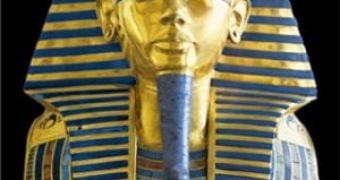King Tut ascended to the throne at age 8 and died at the age of 19, being buried in the Valley of the Kings in Egypt.
His reign, in which the power in fact belonged to his advisor Ay, was insignificant, and his advisor, previously believed as the murderer, took the throne after Tutkankamun's death. However, he became Ancient Egypt's most famous pharaoh when his burial site was found almost completely intact by Howard Carter in 1922, while most other royal tombs had been completely emptied at their discoveries by tomb looters.
Currently, the mummy is in a terrible state, as Carter's team, mostly interested in recovering the jewelry from the Pharaoh's body, hacked it hardly because the jewelry was stuck to the body by resin.
The researchers retrieved some of the pieces missing in 1968, including the King's penis, thumb and parts of the vertebrae lying loose in the sand around the body. Now, an international team has used a mobile CT scanner to get more than 1,900 digital cross-sectional images of the 3,300-year-old mummy, in a study thought as part of a five-year project to image and preserve what is left of Egypt's mummies. "This is the first ever CT evaluation of an identified ancient Royal mummy," Selim said.
The new technology not only makes better the difference between various types of soft tissue and bone, but the body does not have to be removed repeatedly. Since the first radiography of the mummy in 1968, revealing a fractured skull, it has been thought that he was murdered with a blow to the back of the head.
The violent death of the king was supported by turmoil and religious upheaval in Ancient Egypt during his reign. The first CT scan of the Tutankhamun's mummy showed up a key clue: the bone fragments from the pharaoh's first vertebra, resulted from the "blow" near the skull, were not wrapped in balm but clean, thus the damage must have occurred postmortem, after the preparation for burial. "There was no evidence of violent premortum trauma to the skull," said Dr. Ashraf Selim, from the Cairo University in Egypt. "Embalmers took great care in preserving Tut's body, including using two kinds of resin," Selim said.
The ancient embalmers extracted the brain in pieces from the skull through the nose and then poured liquid resin inside the skull through the nose. "This liquid resin would go into the skull, fill it and then it would shortly solidify," Selim said.
"Assume that there are bone fragments inside the skull. The resin will coat all around the loose fragments, and then it solidifies."
"What we found is that these two pieces of bone were lying loosely within the skull, not in the resin at all. This means that they got inside there after the resin was put in, after the embalming."
The researchers believe the loose bone pieces in the skull were broken off when Carter's team tried to take out the golden mask (photo) from the mummy. "It's most likely that the bones broke when Englishman Howard Carter and his team rough-handled the mummy after they discovered it in 1922".
"Resin also glued the mummy to the sarcophagus, and their effort to dislodge it broke many bones," Selim said.
A second key finding was a major fracture in the left thigh bone of the pharaoh. "There is a possible femoral fracture that may have led to his death."
"The femur had a thin coating of embalming resin around the break, indicating that Tut had broken his leg just before he died and that his death may have resulted from an infection or other complications," Selim said.
"When they embalmed the body and poured liquid resin, it went through a wound to coat the edges of the fracture."
Although the break itself was not lethal, it would have provoked an open wound which could have inflicted a lethal infection. Even with the newly discovered fracture, the actual cause of death is still unknown. "Yes, he broke his leg, and, yes, 1337 B.C. medicine wasn't as great as it is today, and perhaps an infection occurred which caused death," said Field Museum archaeologist James Phillips. "But there are other explanations. He might have died of natural causes - even a heart attack, stroke or other type of disease, which was endemic in Egypt. It's still up in the air."

 14 DAY TRIAL //
14 DAY TRIAL //